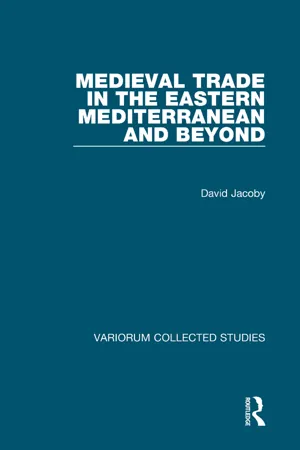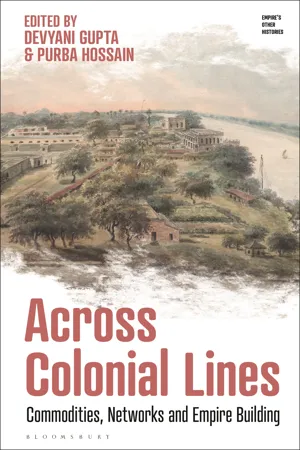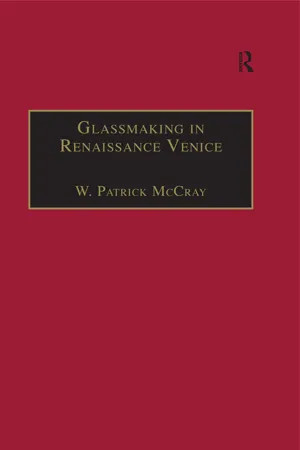History
Venetian Merchants
Venetian merchants were traders from the city of Venice who played a significant role in the Mediterranean and European trade during the Middle Ages and the Renaissance. They established extensive trade networks, particularly in luxury goods such as spices, silk, and precious metals. Their commercial activities contributed to the economic prosperity and cultural influence of Venice during this period.
Written by Perlego with AI-assistance
Related key terms
Related key terms
1 of 4
Related key terms
1 of 3
4 Key excerpts on "Venetian Merchants"
- David Jacoby(Author)
- 2017(Publication Date)
- Routledge(Publisher)
10From the 8th to 10th centuries, Venice concluded a series of treaties with the Lombard, Carolingian and Ottonian rulers successively controlling the neighbouring mainland. The purpose of these treaties was to ensure the preservation of the city’s virtual political independence, the Venetian diffusion of commodities imported by Venice from the eastern Mediterranean, both in northern Italy and beyond the Alps, and the orderly supplies of food, finished products and raw materials from the mainland. Both naval timber from the Alps floated down the rivers to the head of the Adriatic and iron from the area of Brescia in northern Italy and from Carinthia were of special importance in that context.11 The construction of ships for commercial and military use and the manufacture of weapons were key factors in Venice’s commercial and maritime expansion in the Adriatic and in the eastern Mediterranean. Venice boosted its naval power in the 9th century by the adoption of a Byzantine type of galley, technically superior to the ships sailing until then in the Adriatic. The Venetian chronicler Giovanni Diacono reports under the year 852 that two such ships, ‘called zalandriae in the Greek language’, in fact chelandie, were constructed by the doges, and that never before had that been achieved in Venice.12 Their construction implies the presence of Byzantine shipwrights in Venice or the apprenticeship of Venetian craftsmen in Byzantium. Naval timber also became an important export item to Muslim countries by the first half of the 10th- eBook - ePub
Across Colonial Lines
Commodities, Networks and Empire Building
- Devyani Gupta, Purba Hossain(Authors)
- 2023(Publication Date)
- Bloomsbury Academic(Publisher)
1 From commodity trade to ‘virtual’ empire: Venice in the twelfth to fifteenth centuries Andrew BlacklerTraditionally, the fifteenth century has been taken as the beginning of the colonial era, yet it can also be viewed as the culmination of a 300-year period of development that provided the essential tools for Portuguese expansion along the coast of Africa, and the discovery and exploitation of the new world. Some developments were technological – innovations in ship design, cartography and navigation – but others related to nascent processes of colonial organization and administration to exploit the opportunities for commodity trade and cabotage within the Mediterranean basin that emerged among the competing littoral city states of Italy – Amalfi, Pisa, Genoa and Venice.1This trade, and the way in which it defined the structure and practical (as opposed to territorial) extent of the Venetian Republic’s maritime empire, the Stato da Mar, is the focus of this chapter.2 It draws on the author’s research into the history, topography and commodity exports of the Greek island of Euboea, known as Negroponte in the late medieval period, which grew under Venetian suzerainty into the leading city of the Aegean in the late fifteenth century and, following its capture by the Ottomans in 1470, their capital of central Greece. Few local records survive of this period, but the extensive archives of the various political organs of the Venetian state provide a rich resource for understanding the empire’s evolution and organization.3After a short summary of the historical background, I examine the trading flows of commodities within the Eastern Mediterranean, eschewing a focus on one (such as silk or spice), while demonstrating the complexities of their interdependence and then analyse the structures installed by the Venetians to exploit the profits from this trade. These can be understood within the framework of Foucault’s ‘governmentality’, which addresses what he calls ‘government rationality’ – the techniques and practices for governing populations of subjects. Study of the ‘technologies of risk’ followed, later expanded by colleagues to research into the welfare estate. By extension, this enables us to distinguish between what Foucault terms the modern ‘governmental’ state and the sovereign state, which he sees it as superseding.4 Foucault addresses this theme, commencing with the political treatises published from the sixteenth century – something generally followed by later writers. This chapter suggests, however, that discussions on modern government, commodity trade and empires need to encompass the much earlier practical developments in the political and economic institutions of the Italian merchant ‘communes’ – city states from which emerged many of the accounting, limited liability, banking and insurance concepts, which form the pillars of the modern free-market economy.5 - eBook - ePub
Commerce, Peace, and the Arts in Renaissance Venice
Ruzante and the Empire at Center Stage
- Linda L. Carroll(Author)
- 2016(Publication Date)
- Routledge(Publisher)
Introduction: Mercury, Venus, and the Muses Commerce, Peace, and the Arts in Renaissance Venice
Summary
Explored in the three case studies that compose the present volume are intertwining phenomena that developed in Venice in the short distance between the last quarter of the fifteenth century and the first third of the sixteenth century: a strategy developed by some members of the patriciate to cope with their and the Republic’s loss of commerce and international influence by cultivating the economic potential of mainland holdings and of ecclesiastical benefices, their utilization of a dense web of connections in pursuit of their strategy, and their announcement and promotion of it through patronage of the arts.Between 1490 and 1530, the Most Serene Republic was transformed by the rising nation-states and empires from an independent, expanding empire richly financed by lucrative international commerce into a bounded and shrinking dominion strapped by heavy war debts and leanly financed by reduced commercial and agricultural income. Portuguese competition made unavailable to Venetian Merchants most Asian luxury goods at the same time that wars between the northern European states to which Venice had exported them closed those markets to them. Turkish expansion up the Balkan peninsula into imperial and Venetian territory and along the eastern coast of the Mediterranean and the north coast of Africa, as well as increasing raids along the coast of the Italian peninsula, both interfered with galley commerce and posed a grave risk to the supply of foodstuffs and raw materials required by Venice’s large population, dependent on importation from the eastern Mediterranean. While research has established that in the late sixteenth century Venice recouped some Asian trade, it is important not to anticipate that development. In the period in question it was drastically reduced, as is documented in the present study.1 In response, Venetians intensified their previously sporadic investment of commercial profits in industrial and agricultural properties on the mainland permitted by the earlier expansion of the Venetian state as far west as Crema in Lombardy. They developed new and existing industries; particularly lucrative were printing and woolworking in Padua with its book-hungry university and local wool supply and artisans. Silk production was added when Syrian sources were prohibited from exporting to Italy.2 - eBook - ePub
Glassmaking in Renaissance Venice
The Fragile Craft
- W. Patrick McCray(Author)
- 2017(Publication Date)
- Routledge(Publisher)
Generally, the century saw a period of economic growth as industrial activity developed into Venice's primary mainstay. Venice, along with other northern Italian cities, became a centre of technological innovation in manufacturing. Venice's manufacturing guilds, already more numerous than anywhere else in Italy, continued to expand and diversify. 10 Previously, Venice had been a centre for the distribution rather than the manufacture of many goods. This gradually changed by the sixteenth century as Venice enlarged its manufacturing base. This industrial expansion was most spectacular in the woollen industry. This, along with other areas of textile production, is frequently used to gauge the overall performance of Venetian industry in the Renaissance. 11 In addition to more traditional areas of manufacturing such as textile production and shipbuilding, the production of luxury goods – silk, sugar, paper, lace, soap, and glass – increased. Where once Venice was largely an entrepôt for the importation and redistribution of many of these goods, it now was producing and distributing them. It is not easy to clearly separate the commercial and industrial spheres of the economy in Renaissance Venice. Rather than oppose the activities of "commerce" and "industry", it has instead been suggested that the Venetian economy was "metropolitan" with a large degree of overlap between commerce and production. 12 The increased production of staple goods as well as more refined luxury goods was linked by a well-established distribution network. These commercial mechanisms developed as links between trade (both overseas and throughout the rest of Europe) and local Venetian production. The successes of Venice in developing its commercial capitalism facilitated its industrial development. In this sense, commerce and capitalism were part of an "exchange technology". 13 The Venetians developed home industries that were typically geared towards producing export goods
Index pages curate the most relevant extracts from our library of academic textbooks. They’ve been created using an in-house natural language model (NLM), each adding context and meaning to key research topics.
Explore more topic indexes
Explore more topic indexes
1 of 6
Explore more topic indexes
1 of 4



